
TẠP CHÍ KHOA HỌC VÀ CÔNG NGHỆ, Trường Đại học Khoa học, ĐH Huế
Tập 23, Số 1 (2023)
1
ON A FINITE-TIME STABILITY CRITERION FOR DISCRETE-TIME DELAY
NEURAL NETWORKS WITH SECTOR-BOUNDED NEURON
ACTIVATION FUNCTIONS
Le Anh Tuan
Faculty of Mathematics, University of Sciences, Hue University
Email: leanhtuan@hueuni.edu.vn
Received: 18/5/2023; Received in revised form: 22/6/2023; Accepted: 4/12/2023
ABSTRACT
This paper investigates the problem of finite-time stability for discrete-time neural
networks with sector-bounded neuron activation functions and interval-like time-
varying delay. The extended reciprocally convex approach is used to establish a
delay-dependent sufficient condition to ensure finite-time stability for this class of
systems. A numerical example to illustrate the effectiveness of the proposed
criterion is also included.
Key words: Discrete-time neural networks, finite-time stability, linear matrix
inequalities, time-varying delay.
1. INTRODUCTION
In recent decades, neural networks (NNs) with delays have received
considerable attention in analysis and synthesis because their wide applications have
been realized in various fields, such as image processing, signal processing, pattern
recognition, association memory, etc. [1].
The study of dynamic properties of systems over a finite interval of time comes
from many reality systems, such as biochemical reaction systems, communication
network systems, etc. [2]. For the class of discrete-time NNs, there have been some
papers dealing with finite-time stability and boundedness [3, 4]. On the other hand, from
[5], we know that nonlinear functions satisfying the sector-bounded condition are more
general than the usual class of Lipschitz functions. However, up to this point, only a few
authors have investigated general NNs with activation functions satisfying the sector-
bounded condition [6, 7]. That motivated our current study. More specifically, in this
paper, we suggest conditions that guarantee the finite-time stability of discrete-time
delay NNs with sector-bounded neuron activation functions.
The outline of the paper is as follows. Section 2 presents the definition of finite-

On a finite-time stability criterion for discrete-time delay neural networks …
2
time stability and some technical propositions necessary for the proof of the main result.
A delay-dependent criterion in the form of matrix inequalities for finite-time stability
and an illustrative example is presented in Section 3. The paper ends with conclusions
and cited references.
Notation: ℤ+ denotes the set of all non-negative integers; ℝ𝑛 denotes the 𝑛-
dimensional space with the scalar product 𝑥T𝑦; ℝ𝑛×𝑟 denotes the space of (𝑛×
𝑟)−dimension matrices; 𝐴T denotes the transpose of matrix 𝐴; 𝐴 is positive definite
(𝐴>0) if 𝑥T𝐴𝑥>0 for all 𝑥≠0; 𝐴>𝐵 means 𝐴−𝐵>0. The notation diag {…}
stands for a block-diagonal matrix. The symmetric term in a matrix is denoted by ∗.
2. PRELIMINARIES
Consider the following discrete-time neural networks with time-varying delays
{𝑥(𝑘+1)=𝐴𝑥(𝑘)+𝑊𝑓(𝑥(𝑘))+𝑊1𝑔(𝑥(𝑘−ℎ(𝑘))),𝑘∈ℤ+,
𝑥(𝑘)=𝜑(𝑘),𝑘∈{−ℎ2,−ℎ2+1,…,0}, (1)
where 𝑥(𝑘)∈ℝ𝑛 is the state vector; 𝑛 is the number of neurons; the diagonal matrix 𝐴
represents the self-feedback terms; the matrices 𝑊,𝑊1∈ℝ𝑛×𝑛 are connection weight
matrices. 𝑓(𝑥(𝑘)) and 𝑔(𝑥(𝑘−ℎ(𝑘))) are the neuron activation functions. The time-
varying delay function ℎ(𝑘) satisfies the condition
0<ℎ1⩽ℎ(𝑘)⩽ℎ2 ∀𝑘∈ℤ+, (2)
where ℎ1,ℎ2 are given positive integers; 𝜑(𝑘) is the initial function.
In this paper, we use the following assumption for the neuron activation
functions.
Assumption 2.1. [6] The neuron state-based nonlinear functions
𝑓(𝑥(𝑘))=[𝑓1(𝑥1(𝑘)) 𝑓2(𝑥2(𝑘)) … 𝑓𝑛(𝑥𝑛(𝑘))]T,
𝑔(𝑥(𝑘−ℎ(𝑘)))=[𝑔1(𝑥1(𝑘−ℎ(𝑘))) 𝑔2(𝑥2(𝑘−ℎ(𝑘))) … 𝑔𝑛(𝑥𝑛(𝑘−ℎ(𝑘)))]T
are continuous and satisfy 𝑓𝑖(0)=0,𝑔𝑖(0)=0 for 𝑖=1,…,𝑛 and the following sector-
bounded conditions
[𝑓(𝑥)−𝑓(𝑦)−𝑈1(𝑥−𝑦)]T[𝑓(𝑥)−𝑓(𝑦)−𝑈2(𝑥−𝑦)]⩽0,
[𝑔(𝑥)−𝑔(𝑦)−𝑉1(𝑥−𝑦)]T[𝑔(𝑥)−𝑔(𝑦)−𝑉2(𝑥−𝑦)]⩽0, (3)
where 𝑈1,𝑈2,𝑉1 and 𝑉2 are real matrices of appropriate dimensions.
Remark 2.1. Observe that, when 𝑈1=−𝑈2=𝑈 and 𝑉1=−𝑉2=𝑉, condition (3)
becomes
[𝑓(𝑥)−𝑓(𝑦)]T[𝑓(𝑥)−𝑓(𝑦)]⩽[𝑥−𝑦]T𝑈T𝑈[𝑥−𝑦],

TẠP CHÍ KHOA HỌC VÀ CÔNG NGHỆ, Trường Đại học Khoa học, ĐH Huế
Tập 23, Số 1 (2023)
3
[𝑔(𝑥)−𝑔(𝑦)]T[𝑔(𝑥)−𝑔(𝑦)]⩽[𝑥−𝑦]T𝑉T𝑉[𝑥−𝑦].
This implies that the standard Lipschitz conditions ∥𝑓(𝑥)−𝑓(𝑦)∥ ⩽ ∥𝑈(𝑥−𝑦)∥ and
∥𝑔(𝑥)−𝑔(𝑦)∥ ⩽ ∥𝑉(𝑥−𝑦)∥ will be satisfied. Therefore, under Assumption 2.1, the
neural network model (1) is more general than those considered in [1, 4].
Definition 2.1. (Finite-time stability) Given positive constants 𝑐1,𝑐2,𝑁 with 𝑐1<𝑐2,𝑁∈
ℤ+ and a symmetric positive-definite matrix 𝑅, the system (1) is said to be finite-time
stable w.r.t. (𝑐1,𝑐2,𝑅,𝑁) if
max
𝑘∈{−ℎ2,−ℎ2+1,…,0}𝜑T(𝑘)𝑅𝜑(𝑘)⩽𝑐1 ⟹ 𝑥T(𝑘)𝑅𝑥(𝑘)<𝑐2 ∀𝑘∈{1,2,…,𝑁}.
What follows are some technical propositions that will be used to prove the main
result.
Proposition 2.1. (Discrete Jensen Inequality [8]). For any matrix 𝑀∈ℝ𝑛×𝑛,𝑀=𝑀T>0,
positive integers 𝑟1,𝑟2 satisfying 𝑟1⩽𝑟2, a vector function 𝜔: {𝑟1,𝑟1+1,…,𝑟2}→ℝ𝑛, then
(∑𝑟2
𝑖=𝑟1𝜔(𝑖))T𝑀(∑𝑟2
𝑖=𝑟1𝜔(𝑖)) ⩽ (𝑟2−𝑟1+1)∑𝑟2
𝑖=𝑟1𝜔T(𝑖)𝑀𝜔(𝑖).
Proposition 2.2. (Extended Reciprocally Convex Matrix Inequality [9]). Let 𝑅∈ℝ𝑛×𝑛
be a symmetric positive-definite matrix. Then the following matrix inequality
[1
𝛼𝑅 0
01
1−𝛼𝑅] ⩾ [𝑅+(1−𝛼)𝑇1𝑆
∗ 𝑅+𝛼𝑇2] ,
holds for some matrix 𝑆∈ℝ𝑛×𝑛 and for all 𝛼∈(0,1), where 𝑇1=𝑅−𝑆𝑅−1𝑆T,𝑇2=𝑅−
𝑆T𝑅−1𝑆.
Proposition 2.3. (Schur Complement Lemma [10]). Given constant matrices 𝑋,𝑌,𝑍 with
appropriate dimensions satisfying 𝑋=𝑋T,𝑌=𝑌T>0. Then
𝑋+𝑍T𝑌−1𝑍<0 ⟺ [𝑋 𝑍T
𝑍 −𝑌]<0.
3. MAIN RESULT
Let ℎ12=ℎ2−ℎ1,𝑦(𝑘)=𝑥(𝑘+1)−𝑥(𝑘) and let 𝜏 be some positive real
constant such that the following estimate
max
𝑘∈{−ℎ2,−ℎ2+1,…,−1}𝑦T(𝑘)𝑦(𝑘)<𝜏
holds. We define the following matrices to facilitate the presentation of the main result.
𝑈1=1
2(𝑈1T𝑈2+𝑈2T𝑈1),𝑈2=−1
2(𝑈1T+𝑈2T),
𝑉1=1
2(𝑉1T𝑉2+𝑉2T𝑉1),𝑉2=−1
2(𝑉1T+𝑉2T),

On a finite-time stability criterion for discrete-time delay neural networks …
4
Ω11=−𝛿(𝑃+𝑆1)+(ℎ12+1)𝑄+𝑅1−𝑈1,Ω12=𝛿𝑆1,Ω15=−𝑈2,
Ω17=𝐴𝑃,Ω18=ℎ12(𝐴−𝐼)𝑆1,Ω19=ℎ12
2(𝐴−𝐼)𝑆2,
Ωℎ1
22=𝛿ℎ1(−𝑅1+𝑅2−2𝛿𝑆2)−𝛿𝑆1,Ωℎ2
22=𝛿ℎ1(−𝑅1+𝑅2−𝛿𝑆2)−𝛿𝑆1,
Ωℎ1
23=𝛿ℎ1+1(2𝑆2−𝑆),Ωℎ2
23=𝛿ℎ1+1(𝑆2−𝑆),Ω24=𝛿ℎ1+1𝑆,Ωℎ1
2,10=−𝛿ℎ1+1𝑆,
Ω33=−𝛿ℎ1𝑄−𝛿ℎ1+1(3𝑆2−𝑆−𝑆T)−𝑉1,Ωℎ1
34=𝛿ℎ1+1(𝑆2−𝑆),
Ωℎ2
34=𝛿ℎ1+1(2𝑆2−𝑆),Ω36=−𝑉2,Ωℎ1
3,10=𝛿ℎ1+1𝑆,Ωℎ2
3,10=−𝛿ℎ1+1𝑆T,
Ωℎ1
44=−𝛿ℎ2𝑅2−𝛿ℎ1+1𝑆2,Ωℎ2
44=−𝛿ℎ2𝑅2−2𝛿ℎ1+1𝑆2,Ωℎ2
4,10=𝛿ℎ1+1𝑆T,
Ω55=Ω66=−𝐼,Ω57=𝑊T𝑃,Ω58=ℎ12𝑊T𝑆1,Ω59=ℎ12
2𝑊T𝑆2,
Ω67=𝑊1T𝑃,Ω68=ℎ12𝑊1T𝑆1,Ω69=ℎ12
2𝑊1T𝑆2,
Ω77=−𝑃,Ω88=−ℎ12𝑆1,Ω99=−ℎ12
2𝑆2,Ω10,10=−𝛿ℎ1+1𝑆2,
𝜌1= 1
2𝑐1(ℎ1+ℎ2)(ℎ12+1)𝛿𝑁+ℎ2,𝜌2= 1
2𝜏ℎ12
2(ℎ1+ℎ2+1)𝛿𝑁+ℎ2,
Λ11=−𝑐2𝛿𝜆1,Λ12=𝑐1𝛿𝑁+1𝜆2,Λ13=𝜌1𝜆3,Λ14=𝑐1ℎ1𝛿𝑁+ℎ1𝜆4,
Λ15=𝑐1ℎ12𝛿𝑁+ℎ2𝜆5,Λ16=1
2𝜏ℎ12(ℎ1+1)𝛿𝑁+ℎ1𝜆6,Λ17=𝜌2𝜆7,
Λ22=−𝑐1𝛿𝑁+1𝜆2,Λ33=−𝜌1𝜆3,Λ44=−𝑐1ℎ1𝛿𝑁+ℎ1𝜆4,
Λ55=−𝑐1ℎ12𝛿𝑁+ℎ2𝜆5,Λ66=−1
2𝜏ℎ12(ℎ1+1)𝛿𝑁+ℎ1𝜆6,Λ77=−𝜌2𝜆7,
Λ𝑖𝑗=0 for any other 𝑖,𝑗: 𝑗>𝑖,Λ𝑖𝑗= (Λ𝑗𝑖)T,𝑖>𝑗.
Theorem 3.1. Given positive constants 𝑐1,𝑐2,𝛾,𝑁 with 𝑐1<𝑐2,𝑁∈ℤ+ and a symmetric
positive-definite matrix 𝑅. System (1) is finite-time stable w.r.t. (𝑐1,𝑐2,𝑅,𝑁) if there exist
symmetric positive definite matrices 𝑃,𝑄,𝑅1,𝑅2,𝑆1,𝑆2∈ℝ𝑛×𝑛, a matrix 𝑆∈ℝ𝑛×𝑛 and
positive scalars 𝜆𝑖,𝑖=1,7, 𝛿⩾1, such that the following matrix inequalities hold:
𝜆1𝑅<𝑃<𝜆2𝑅,𝑄<𝜆3𝑅,𝑅1<𝜆4𝑅,𝑅2<𝜆5𝑅,𝑆1<𝜆6𝐼,𝑆2<𝜆7𝐼, (4)
Ωℎ1=
[
Ω11 Ω12 0 0 Ω15 0 Ω17 Ω18 Ω19 0
∗ Ωℎ1
22 Ωℎ1
23 Ω24 0 0 0 0 0 Ωℎ1
2,10
∗ ∗ Ω33 Ωℎ1
34 0 Ω36 0 0 0 Ωℎ1
3,10
∗ ∗ ∗ Ωℎ1
44 0 0 0 0 0 0
∗ ∗ ∗ ∗ Ω55 0 Ω57 Ω58 Ω59 0
∗ ∗ ∗ ∗ ∗ Ω66 Ω67 Ω68 Ω69 0
∗ ∗ ∗ ∗ ∗ ∗ Ω77 0 0 0
∗ ∗ ∗ ∗ ∗ ∗ ∗ Ω88 0 0
∗∗∗∗∗∗∗∗Ω99 0
∗ ∗ ∗ ∗ ∗ ∗ ∗ ∗ ∗ Ω10,10
]
<0, (5)

TẠP CHÍ KHOA HỌC VÀ CÔNG NGHỆ, Trường Đại học Khoa học, ĐH Huế
Tập 23, Số 1 (2023)
5
Ωℎ2=
[
Ω11 Ω12 0 0 Ω15 0 Ω17 Ω18 Ω19 0
∗ Ωℎ2
22 Ωℎ2
23 Ω24 0 0 0 0 0 0
∗ ∗ Ω33 Ωℎ2
34 0 Ω36 0 0 0 Ωℎ2
3,10
∗ ∗ ∗ Ωℎ2
44 0 0 0 0 0 Ωℎ2
4,10
∗ ∗ ∗ ∗ Ω55 0 Ω57 Ω58 Ω59 0
∗ ∗ ∗ ∗ ∗ Ω66 Ω67 Ω68 Ω69 0
∗ ∗ ∗ ∗ ∗ ∗ Ω77 0 0 0
∗ ∗ ∗ ∗ ∗ ∗ ∗ Ω88 0 0
∗∗∗∗∗∗∗∗Ω99 0
∗ ∗ ∗ ∗ ∗ ∗ ∗ ∗ ∗ Ω10,10
]
<0, (6)
Λ=[Λ𝑖𝑗]7×7<0. (7)
Proof. Consider the following Lyapunov–Krasovskii functional:
𝑉(𝑘)=∑
4
𝑖=1𝑉𝑖(𝑘),
where
𝑉1(𝑘)=𝑥T(𝑘)𝑃𝑥(𝑘),
𝑉2(𝑘)=∑−ℎ1+1
𝑠=−ℎ2+1∑𝑘−1
𝑡=𝑘−1+𝑠𝛿𝑘−1−𝑡𝑥T(𝑡)𝑄𝑥(𝑡),
𝑉3(𝑘)=∑𝑘−1
𝑠=𝑘−ℎ1𝛿𝑘−1−𝑠𝑥T(𝑠)𝑅1𝑥(𝑠)+∑𝑘−ℎ1−1
𝑠=𝑘−ℎ2𝛿𝑘−1−𝑠𝑥T(𝑠)𝑅2𝑥(𝑠),
𝑉4(𝑘)=∑0
𝑠=−ℎ1+1∑𝑘−1
𝑡=𝑘−1+𝑠ℎ1𝛿𝑘−1−𝑡𝑦T(𝑡)𝑆1𝑦(𝑡)+
+∑−ℎ1
𝑠=−ℎ2+1∑𝑘−1
𝑡=𝑘−1+𝑠ℎ12𝛿𝑘−1−𝑡𝑦T(𝑡)𝑆2𝑦(𝑡).
By denoting 𝜂(𝑘):=[𝑥T(𝑘) 𝑓T(𝑥(𝑘)) 𝑔T(𝑥(𝑘−ℎ(𝑘)))]T,𝛤:=[𝐴 𝑊 𝑊1], we have
the following estimates for the difference variation of 𝑉𝑖(𝑘),𝑖=1,…,4:
𝑉1(𝑘+1)−𝛿𝑉1(𝑘)=𝜂T(𝑘)𝛤T𝑃𝛤𝜂(𝑘)−𝛿𝑥T(𝑘)𝑃𝑥(𝑘), (8)
𝑉2(𝑘+1)−𝛿𝑉2(𝑘)⩽(ℎ12+1)𝑥T(𝑘)𝑄𝑥(𝑘)−𝛿ℎ1𝑥T(𝑘−ℎ(𝑘))𝑄𝑥(𝑘−ℎ(𝑘)), (9)
𝑉3(𝑘+1)−𝛿𝑉3(𝑘)=𝑥T(𝑘)𝑅1𝑥(𝑘)+𝑥T(𝑘−ℎ1)[𝛿ℎ1(−𝑅1+𝑅2)]𝑥(𝑘−ℎ1)
− 𝛿ℎ2𝑥T(𝑘−ℎ2)𝑅2𝑥(𝑘−ℎ2), (10)
𝑉4(𝑘+1)−𝛿𝑉4(𝑘)⩽𝑦T(𝑘)[ℎ12𝑆1+ℎ12
2𝑆2]𝑦(𝑘)−ℎ1𝛿∑𝑘−1
𝑠=𝑘−ℎ1𝑦T(𝑠)𝑆1𝑦(𝑠)
− ℎ12𝛿ℎ1+1∑𝑘−1−ℎ1
𝑠=𝑘−ℎ2𝑦T(𝑠)𝑆2𝑦(𝑠). (11)
By Proposition 2.1,
−ℎ1𝛿∑𝑘−1
𝑠=𝑘−ℎ1𝑦T(𝑠)𝑆1𝑦(𝑠)⩽−𝛿[𝑥(𝑘)−𝑥(𝑘−ℎ1)]T𝑆1[𝑥(𝑘)−𝑥(𝑘−ℎ1)], (12)
−ℎ12𝛿ℎ1+1∑𝑘−1−ℎ1
𝑠=𝑘−ℎ2𝑦T(𝑠)𝑆2𝑦(𝑠)⩽−𝛿ℎ1+1(1
(ℎ(𝑘)−ℎ1)/ℎ12𝜁1T𝑆2𝜁1+1
(ℎ2−ℎ(𝑘))/ℎ12𝜁2T𝑆2𝜁2)
=−𝛿ℎ1+1(1
𝛼𝜁1T𝑆2𝜁1+1
1−𝛼𝜁2T𝑆2𝜁2)


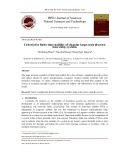
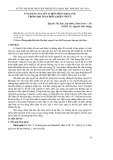
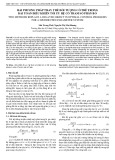
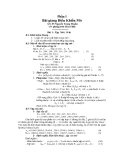
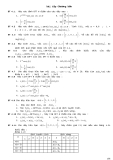
















![Quyển ghi Xác suất và Thống kê [chuẩn nhất]](https://cdn.tailieu.vn/images/document/thumbnail/2025/20251030/anh26012006/135x160/68811762164229.jpg)
